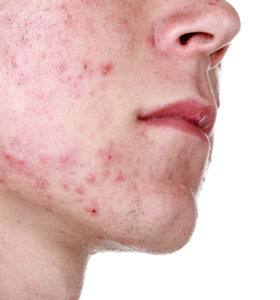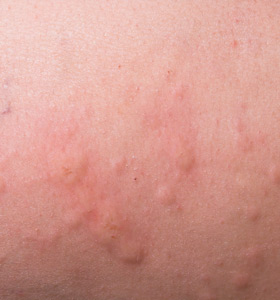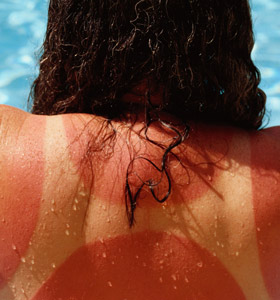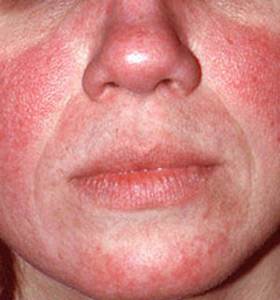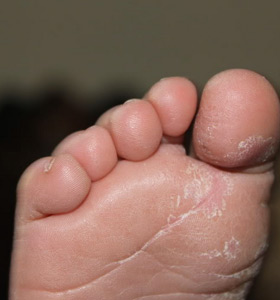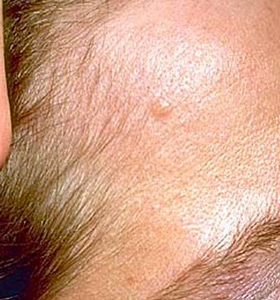What are the most common skin conditions? (with photos)
Did you know that your skin is the largest organ in your body? So skin problems can be big problems. Follow along to see and learn how to handle skin setbacks from shingles to athlete's foot.
1. Acne (Acne vulgaris)
Acne, the most common skin disorder in the U.S., can be a source of anxiety for every teen. Plus, the incidence of acne is growing in adults, too.
Acne is caused by blocked hair follicles and oil (sebaceous) glands of the skin, often triggered by hormonal changes. The term acne refers to not only pimples on the face, but blackheads, cysts, and nodules as well. Some people get acne on other parts of their body too, such as the back and chest.
Acne treatment by a dermatologist is important because acne left unchecked can often lead to permanent scars and dark facial spots. For more moderate or severe acne, these options may be used:
- Adapalene topical (Differin) cream is now available over-the-counter without a prescription.
- Tretinoin topical (Retin-A, Avita, Altreno, other brands and generics) is also available in creams, gels and lotions. Discuss the use of this drug with your doctor: tretinoin should not be used during pregnancy unless clearly needed and the benefit outweighs the risk to the fetus.
- In severe acne cases, oral isotretinoin (Amnesteem, Claravis, other brands and generics) may be used, but comes with serious pregnancy warnings. This drug should not be used by female patients who are or may become pregnant. There is an extremely high risk that severe birth defects will result if pregnancy occurs while taking this drug.
- In October 2018, sarecycline (Seysara) tablets were FDA-approved for the treatment of non-nodular moderate to severe acne vulgaris.
- Tazarotene topical (Arazlo, Fabior, Tazorac), tretinoin and benzoyl peroxide (Twyneo), and clascoterone (Winlevi) are other topical cream acne prescription options.
See managing and treating acne for other treatment options.
2. Atopic dermatitis (Eczema)
Atopic dermatitis is one of the most common forms of eczema seen in children. The exact cause of atopic dermatitis is not known, but researchers believe it may involve genetics, the environment, and/or the immune system.
Atopic dermatitis can appear on the face (especially in infants), hands, feet or in the creases and folds of the skin. Dry, scaly and itchy skin are the norm, and constant scratching may lead to a thickened area. While eczema often occurs in people with allergies, allergies do not cause eczema. Topical steroids are often used to lessen symptoms.
Dupixent
- In March 2017, the FDA cleared Regeneron’s Dupixent (dupilumab) injection to paptients with moderate-to-severe eczema who cannot use or have failed topical therapy.
- Clinical trials of Dupixent in over 2,100 adults with moderate-to-severe atopic dermatitis led to clear or almost clear skin as compared to placebo, with a reduction in itching, after 16 weeks of therapy.
- Dupixent is now also approved for use in pediatric patients 6 to 17 years of age and is available in a prefilled syringe for more convenient self-administration.
- Dupixent can be used with or without topical corticosteroids.
Eucrisa
- Eucrisa (crisaborole), from Pfizer, is a topical ointment first approved in Dec. 2016.
- It is classified as a phosphodiesterase 4 inhibitor and used for mild to moderate eczema in adults and children 3 months of age and older.
- It is applied a thin layer to the affected areas 2 times each day.
Other atopic dermatitis approvals include Opzelura (ruxolitinib) cream, approved in Sept. 2021 and Adbry (tralokinumab-ldrm) approved in Dec. 2021, Rinvoq (upadacitinib) in Jan. 2022, and Cibinqo (abrocitinib) in Jan. 2022.
3. Shingles (Herpes Zoster)
Shingles virus (herpes zoster) results in a red, blistered rash that may wrap around your torso or appear anywhere on your body. A fever, fatigue and headache may occur, too.
Shingles is caused by the same virus that causes chickenpox - the varicella-zoster virus. If you've had chickenpox, you're at risk for shingles as the chickenpox virus lies dormant (not active) in your nervous system for years. One preventive shingles vaccine is available in the United States:
- Shingrix (herpes zoster subunit vaccine) is approved for the prevention of shingles (herpes zoster) in adults aged 50 years and older.
- Shingrix is a non-live (inactivated), recombinant subunit vaccine given intramuscularly in two doses, with the second dose given 2 to 6 months after the first.
- Shingrix has demonstrated a high rate of effectiveness (>90% effective).
Zostavax (zoster vaccine live) was formerly available as a subcutaneous injection to prevent shingles, but in November 2020 Zostavax vaccine was discontinued in the United States.
Seniors and people with an impaired immune system are at highest risk. Shingles can be painful, but early treatment with antivirals like oral valacyclovir (Valtrex) can lessen symptoms.
4. Hives (Urticaria)
Hives are the familiar welts (raised, red, itchy areas) that can occur on the skin. Common causes of hives include medication, food, and bug bites or stings.
Seek urgent treatment or call 911 if your hives cover a large area of your body, your throat or facial area is swelling, or they affect your breathing. Hives usually go away in 2 to 4 hours; however, in some people hives may persist for months or years; this is known as chronic urticaria.
Avoiding the trigger, whatever it may be, is the best tactic to prevent hives. When that is not possible, OTC antihistamines like loratadine (Claritin) or fexofenadine (Allegra) can be used to control itching.
A drug used to treat allergic asthma, omalizumab (Xolair injection), was approved in 2014 to treat chronic urticaria in those with no response to antihistamines.
In October 2019, Quzyttir (cetrizine injection) was approved by the FDA to treat acute urticaria (hives) in adults and children 6 months of age and older. Quzyttir is not recommended in children less than 6 years of age with impaired kidney or liver function.
5. Sunburn
There's no doubt - it's easier to prevent a sunburn than to treat one.
Sunburns occur when there is too much exposure to ultraviolet (UV) light from the sun or sunlamps. The skin turns red, painful, hot to the touch, and may even peel away.
It's hard to know how much time is safe in the sun, though, even with sunscreen protection. Repeated sunburns, especially as a child, can boost the risk for skin cancer later in life. Usually sunscreen needs to be reapplied every 2 hours, but you may just need to stay out of the sun, too.
The first step in treating a sunburn is to seek shade, get inside if possible, and cool the skin down.
- Take a cool bath or shower with a mild soap.
- Drink plenty of fluids and moisturize the skin with a light, oil-free moisturizer or aloe vera while the skin is still damp.
- In some cases, an OTC topical product with lidocaine might be needed.
- Taking an NSAID, such as ibuprofen, can help with any discomfort or swelling.
See a doctor if you have a fever, chills or severe blistering over a large portion of your body. Don't scratch or pop any blisters - this could lead to infection.
Related questions
- Is it OK to take antihistamines every day?
- Allegra vs Claritin: Which is more effective for allergies?
- Allegra vs Zyrtec: What's the difference?
6. Contact Dermatitis
Most of us have had contact dermatitis - when we touch something that evolves into a skin reaction.
- Contact dermatitis is a type of eczema, and may come from plants (poison ivy, sumac, oak), jewelry, latex gloves, and irritants like bleach or soaps.
- To prevent contact dermatitis, avoid the object when possible.
- To control symptoms, antihistamines, oral or topical steroids, and colloidal oatmeal baths are often helpful.
If your doctor suspects you have contact dermatitis, and the cause is unknown, they may suggest patch testing. In patch testing, allergic substances are applied to your skin. In a few days, your doctor will check for a reaction.
7. Diaper Rash
Anyone who has a child knows about the common problem of diaper rash.
- A wet or soiled diaper left on too long can lead to red bumps and rash in the diaper area, the buttocks, genitals, and skin folds.
- Urine and stool can break down skin, and chemicals in a disposable diaper can dissolve out and irritate the skin.
- Candida (yeast) or bacteria can also take advantage of the inflammed, broken, skin and complicate the rash.
To help prevent diaper rash, change diapers as needed to keep the area dry and expose the baby's bottom to fresh air when possible.
You can use an ointment like Desitin (zinc oxide topical) to form a protective barrier on the baby's bottom. If the rash still persists after 2 to 3 days, consult with your pediatrician.
8. Rosacea
Rosacea is a chronic swelling of the face, with redness, prominent blood vessels, and pimples.
Rosacea is most common in women over 30, but men can be affected too. Problems with the immune system, vein problems and/or environmental issues can cause the condition.
Depending upon the symptoms, there are several effective treatments.
- Antibiotics, such as metronidazole cream or oral doxycycline can be used. In May 2020, the FDA approved Zilxi (metronidazole) topical foam for the treatment of rosacea.
- Azelaic acid gel (Finacea), a naturally-occurring saturated dicarboxylic acid, can be used for the inflammed pimples.
- For more severe cases, your doctor might suggest the acne drug isotretinoin.
- Beta blockers (to reduce flushing), the smallest dose of estrogen possible, or laser or surgical treatments may also reduce redness.
- In January 2017, the FDA approved Rhofade (oxymetazoline) cream, a topical vasoconstrictor agent applied to the face once a day to shrink vessels and lessen the facial redness of rosacea in adults. Other prescription items include Soolantra (ivermectin), Mirvaso (brimonidine and Epsolay (benzoyl peroxide) cream.
9. Athlete's Foot (Tinea Pedis)
It's an unfortunate fact, but your feet are prone to fungal infections. Athlete’s foot can lead to extreme itching, redness, and cracked skin on the feet and in between the toes. A type of fungi called dermatophytes are commonly found in warm, moist areas like pool decks, shower stalls, and locker rooms.
Luckily, over-the-counter, topical antifungal treatments are readily available in creams and sprays, such as:
It can take weeks for the infection to clear; check with your doctor if symptoms do not improve as you may need a prescription strength product.
You can help prevent athlete’s foot by keeping your feet clean and dry, changing wet socks and shoes, and wearing sandals in public pool or shower areas.
If fungus creeps under your toe nails, which can appear as a white, yellow or brown color with crumbly texture to your nail, be sure to see a podiatrist as more intensive treatment may be needed.
10. Basal Cell Carcinoma
Basal cell carcinoma (BCC) is the most common type of skin cancer in the U.S. BCC grows in the upper basal cells of your skin but rarely spreads and is curable. You may be prone to BCCs if you spend lots of time in the sun or use a tanning bed frequently.
Growths commonly occur on the head, ears, nose, and neck. They can look shiny, red and scaly, or like an open sore.
Treatment for BCC may involve:
- surgery
- skin medicines for smaller areas
- radiation for larger ones.
Medications include products like:
- imiquimod (Aldara cream, Zyclara cream)
- fluorouracil (Carac cream)
Sonidegib (Odomzo) and vismodegib (Erivedge) are oral formulations that may be used for more advanced BCC that has recurred following surgery or radiation therapy, or for patients who cannot have surgery or radiation therapy.
To prevent BCC, avoid long periods of sun exposure, use sunscreen, wear protective clothing, and visit your dermatologist annually for a full body skin checks. Learn to perform skin self-checks, too. Those with a strong personal or family history of skins cancer may need to visit more frequently. If you notice something unusual, don't wait to see your doctor.
References
- Shingrix. Product Labeling. GlaxoSmithkline. Research Triangle Park, NC. 2017. Accessed Sept. 21, 2021 at https://www.shingrix.com/index.html
- Shingles Vaccination. What Everyone Should Know about Shingles Vaccine (Shingrix). US Centers for Disease Control and Prevention (CDC). Accessed Sept. 20, 2021 at https://www.cdc.gov/vaccines/vpd/shingles/public/shingrix/index.html
- American Academy of Dermatology. Disease and Treatments. Acne. Accessed Sept. 20, 2021 at https://www.aad.org/public/diseases/acne-and-rosacea/acne
- American Academy of Dermatology. Disease and Treatments. Atopic Dermatitis. Signs and Symptoms. Accessed Sept. 20, 2021 at https://www.aad.org/public/diseases/eczema/types/atopic-dermatitis/self-care
- Asthma and Allergy Foundation of America. Hives (urticaria). Accessed Sept. 20, 2021 at https://www.aafa.org/page/hives.aspx
- Skin Cancer Foundation. Sunburn and Your Skin. Accessed Sept. 20, 2021 at https://www.skincancer.org/prevention/sunburn/five-ways-to-treat-a-sunburn
- American Academy of Dermatology. Contact dermatitis. Accessed Sept. 20, 2021 at https://www.aad.org/dermatology-a-to-z/diseases-and-treatments/a---d/contact-dermatitis
- American Academy of Dermatology. Disease and Treatments. Basal Cell Carcinoma: Overview. Accessed Sept. 20, 2021 at https://www.aad.org/public/diseases/skin-cancer/basal-cell-carcinoma
Read next
Is Doxycycline safe for dogs? Uses, dosage, side effects
Doxycycline is usually well tolerated and is considered safe for dogs. It is widely prescribed for a range of different conditions such as bacterial infections and oral gum disease. Continue reading
Doxycycline for STDs: Effectiveness, Dosage and Side Effects
Doxycycline is an antibiotic that can be taken within 72 hours of unprotected sex to help prevent common bacterial STDs (sexually transmitted diseases). When doxycycline is used in this way it is called Doxy PEP (postexposure prophylaxis). Doxy PEP significantly protects against 3 STDs, syphilis, chlamydia, and gonorrhea, in high-risk, sexually active adults. STDs may also be called sexually transmitted infections or STIs.
Continue reading
Should doxycycline be taken with food?
Doxycycline, a tetracycline antibiotic, is used to treat many different bacterial infections and skin conditions such as acne and rosacea. Different doxycycline products may have different instructions for how to take the medication. In general, most brands of doxycycline may be taken with food.
Continue readingSee also:
Related medical questions
- Which antihistamines make you drowsy?
- Can I take Allegra in the morning and Zyrtec in the evening?
- How do you choose the right allergy medication?
- Why do drugs have brand names and a generic name?
- Does doxycycline work for acne?
- What are the best antibiotics for pneumonia?
- What is the best antibiotic to treat a sinus infection?
- Does Doxycycline make you tired?
- Can I take doxycycline for a strep throat?
- How long after stopping doxycycline can I drink alcohol?
- What causes black hairy tongue?
- What is doxycycline hyclate used for?
- How long does doxycycline stay in your body?
- Can I take doxycycline if I am allergic to penicillin?
- Can you smoke cigarettes or marijuana on doxycycline hyclate?
- Will it be harmful to take doxycycline with iron supplements?
- Is doxycycline hydrochloride 100mg a sulfa based drug?
- Does doxycycline cause kidney pain?
- What happens if you drink alcohol with metronidazole?
- How long does it take for metronidazole to work?
- Is metronidazole safe for dogs? Uses, dosage, side effects?
- What can I do about the metallic taste of Flagyl?
- Can metronidazole cause a yeast infection?
- Does metronidazole treat chlamydia?
- Can you have sex while taking metronidazole?
- Does Flagyl cause diarrhea?
- How long does it take metronidazole to leave your system?
- What do I need to know about Drug Interactions?
- Can you use Soolantra and metronidazole together?
Related support groups
- Allegra (39 questions, 49 members)
- Doxycycline (134 questions, 255 members)
- Metronidazole (129 questions, 350 members)
- Claritin (43 questions, 64 members)
- Loratadine (33 questions, 62 members)
- Dupixent (31 questions, 64 members)
- Terbinafine (26 questions, 67 members)
- Xolair (26 questions, 89 members)
- Valtrex (25 questions, 92 members)
- Valacyclovir (22 questions, 63 members)
- Clotrimazole (19 questions, 26 members)

